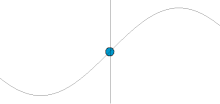Wave vector
A wave vector (also spelled wavevector) is a vector which helps describe a wave. Like any vector, it has a magnitude and direction, both of which are important: Its magnitude is either the wavenumber or angular wavenumber of the wave (inversely proportional to the wavelength), and its direction is the direction of wave propagation.
The wave vector can also be defined as a four-vector in the context of special relativity.
Definitions


Unfortunately, there are two common definitions of wave vector which differ by a factor of in their magnitudes. In general, one definition is preferred in physics and related fields, while the other definition is preferred in crystallography and related fields.[1] For this article, they will be called the "physics definition" and the "crystallography definition", respectively.
Physics definition
A perfect one-dimensional traveling wave follows the equation:
where:
- x is position,
- t is time,
- (a function of x and t) is the disturbance describing the wave (for example, for an ocean wave, would be the excess height of the water, or for a sound wave, would be the excess air pressure).
- A is the amplitude of the wave (the peak magnitude of the oscillation),
- is a "phase offset" describing how two waves can be out of sync with each other,
- is the angular frequency of the wave, related to how quickly it oscillates at a given point,
- is the wavenumber (more specifically called angular wavenumber) of the wave, related to the wavelength by the equation .
This wave travels in the +x direction with speed (more specifically, phase velocity) .
This formula is generalized to three dimensions by:
where:
- r is the position vector in three-dimensional space,
- is the vector dot product.
- k is the wave vector.
This formula describes a plane wave. The magnitude of the wave vector is the angular wavenumber as in the one-dimensional case above: . The direction of the wave vector is the direction that the plane wave is traveling.
Crystallography definition
In crystallography, the same waves are described using slightly different equations.[2] In one and three dimensions respectively:
The differences are:
- The frequency instead of angular frequency is used. They are related by . This substitution is not important for this article, but reflects common practice in crystallography.
- The wavenumber k and wave vector k are defined in a different way. Here, , while in the physics definition above, .
In special relativity
A wave packet of nearly monochromatic light can be characterized by the wave vector
which, when written out explicitly in its contravariant and covariant forms is
- and
The magnitude of this wave vector is then
That last step where it equals zero, is a result of the fact that, for light in vacuum,
Lorentz transform
Taking the Lorentz transform of the wave vector is one way to derive the relativistic Doppler effect. The Lorentz matrix is defined as
In the situation where light is being emitted by a fast moving source and one would like to know the frequency of light detected in an earth (lab) frame, we would apply the lorentz transform as follows. Note that the source is in a frame Ss and earth is in the observing frame, Sobs. Applying the lorentz transformation to the wave vector
and choosing just to look at the component results in
where is the direction cosine of wrt
So
Source moving away
As an example, to apply this to a situation where the source is moving directly away from the observer (), this becomes:
Source moving towards
To apply this to a situation where the source is moving straight towards the observer (), this becomes:
References
- Brau, Charles A. (2004). Modern Problems in Classical Electrodynamics. Oxford University Press. ISBN 0-19-514665-4.
- ^ Physics definition example: Handbook of Physics, by Harris, Benenson, Stöcker, p288. Crystallography definition example: Modern Crystallography by Vaĭnshteĭn, p 259.
- ^ Modern Crystallography by Vaĭnshteĭn, p 259






































